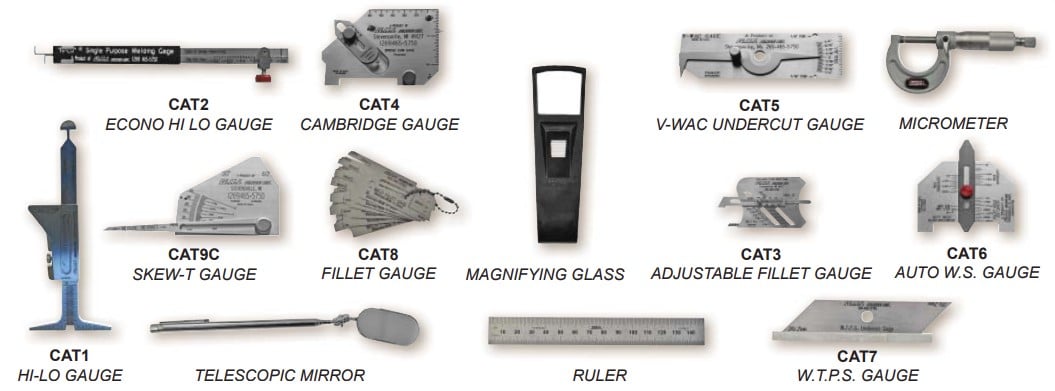The Impact of Welding Inspection Milwaukee on Task Success and Conformity

Checking Out the Various Approaches and Criteria of Welding Examination for Getting Conformity and Reliability in Engineering Applications
The relevance of welding examination in design applications can not be overemphasized, as it serves as a critical guard for guaranteeing architectural stability and compliance with sector requirements. Various methods, including aesthetic inspection and advanced non-destructive screening techniques, provide vital understandings right into the quality of welds.
Value of Welding Assessment
Welding evaluation plays a vital role in ensuring the honesty and security of welded structures. This procedure includes the organized assessment of welds to verify compliance with predetermined requirements and specs. The significance of welding assessment can not be overstated, as it acts as a safeguard against potential failings that might arise from insufficient welding practices. With extensive inspection, issues such as cracks, gaps, and poor blend can be identified early, therefore protecting against catastrophic failings that may cause structural collapse or safety and security threats.
Additionally, welding inspection is crucial for keeping quality control throughout the welding process. It makes certain that the welds fulfill the required mechanical and physical properties needed for their intended applications. Routine assessments additionally promote a society of responsibility and continual improvement within welding operations, encouraging adherence to best techniques and industry requirements.
In controlled sectors such as manufacturing, aerospace, and building, rigid welding examination methods are mandated to adhere to lawful and safety and security needs. Ultimately, effective welding inspection not just shields human life and residential property but also enhances the long life and dependability of welded structures, making it a vital element of engineering and building and construction.

Common Welding Assessment Approaches
A variety of assessment approaches are used to assess the high quality and integrity of welds, each tailored to find details types of problems. Amongst one of the most common methods is visual examination, which includes a complete assessment of the weld surface to determine noticeable imperfections such as cracks, undercuts, and insufficient blend. This method is frequently the very first step in the inspection procedure due to its simpleness and cost-effectiveness.
An additional extensively used method is radiographic inspection, where X-rays or gamma rays penetrate the weld to reveal internal defects. This technique is particularly reliable for detecting porosity and inclusions within the weld material. Similarly, ultrasonic screening utilizes high-frequency sound waves to recognize internal problems, offering a comprehensive evaluation of the weld's honesty.
Furthermore, magnetic fragment assessment is utilized for ferromagnetic products, enabling the discovery of surface and near-surface defects by using magnetic fields and observing bit patterns. Dye penetrant testing entails applying a fluid dye to the weld surface, disclosing cracks and various other gaps upon inspection (Welding Inspection Milwaukee). Each of these techniques plays a critical duty in making sure weld quality and compliance with market requirements
Non-Destructive Evaluating Strategies
Non-destructive screening (NDT) techniques are crucial devices in the assessment of weld top quality, allowing examiners to review the honesty of welded joints without creating damages to the materials. Different NDT techniques are used to determine possible issues, ensuring that welds satisfy the called for standards for security and efficiency.
Among the most common strategies is ultrasonic testing (UT), which makes use of high-frequency sound waves to find interior flaws such as voids or cracks. Radiographic testing (RT) employs X-rays or gamma rays to produce images of welds, revealing any stoppages within the product. Magnetic fragment screening (MT) works for detecting surface area and near-surface issues in ferromagnetic products via the application of magnetic areas and contrasting bits.
Liquid penetrant testing (PT) is one more commonly used method that involves applying a dye to the surface of the weld, which seeps into any fractures, making them visible under ultraviolet light. Each of these approaches supplies one-of-a-kind advantages and constraints, and the selection of a proper technique is crucial to achieving accurate analyses of weld stability. Ultimately, the execution of NDT techniques substantially adds to the integrity and security of engineering applications.

Governing Specifications and Conformity
In the realm of welding examination, adherence to governing requirements and conformity is critical to ensure the safety and security and integrity of welded frameworks (Welding Inspection Milwaukee). Numerous organizations, consisting of the American Welding Culture (AWS), the American Society Discover More of Mechanical Designers (ASME), and the International Company for Standardization (ISO), have developed standards that regulate welding practices and assessment procedures. These standards offer a structure for quality control, outlining the required certifications for inspectors and the methods for analyzing weld stability
Compliance with these regulative criteria not just boosts the structural integrity of welded assemblies but also minimizes risks connected with failings, which can have tragic consequences. Inspections need to be executed using defined procedures, including visual, ultrasonic, and radiographic methods, to guarantee that welds satisfy specified criteria.
Furthermore, adherence to these requirements is typically needed by legislation, especially in sectors such as building, aerospace, and manufacturing. Routine audits and accreditations are necessary to keep compliance, therefore promoting a society of safety and high quality within organizations. Eventually, governing standards and conformity work as the foundation of trustworthy welding evaluation techniques, making sure that engineered structures satisfy both efficiency expectations and security demands.
Finest Practices for Welding Examination
While maintaining compliance with regulative requirements is vital, implementing best methods for welding assessment better enhances the security and stability of bonded frameworks. Reliable welding evaluation starts with comprehensive planning, that includes comprehending the certain needs of each task and ensuring inspectors are well-trained in applicable techniques and criteria.
Making use of a thorough inspection list helps to guarantee all vital elements are assessed, such as weld dimension, infiltration, and aesthetic flaws. Non-destructive screening (NDT) methods, such as ultrasonic or radiographic testing, ought to be utilized where suitable, giving a much more in-depth assessment of weld quality without endangering the stability of the materials.
Documentation plays a considerable role in ideal methods; maintaining exact records of evaluations, including photos, test outcomes, and conformity records, guarantees accountability and facilitates future analyses. In addition, cultivating a culture of open interaction between welders and inspectors can result in early recognition of potential concerns, promoting immediate restorative actions.
Verdict
In summary, the application of rigorous welding examination methods and adherence to established requirements are important for making certain compliance and dependability in design applications - Welding Inspection Milwaukee. Techniques such as aesthetic inspection, radiographic testing, and ultrasonic testing function as vital tools in keeping and identifying problems high quality assurance. By promoting a society of accountability and excellence, organizations can improve the integrity and durability of welded structures, eventually adding to the safety and security and effectiveness of design jobs
Different approaches, including aesthetic examination and advanced non-destructive testing strategies, give vital understandings right into the top quality of welds.Welding inspection plays an essential article duty in making sure the stability and safety and security of bonded frameworks.A selection of evaluation techniques are employed to assess the high quality and honesty of welds, each tailored to detect specific kinds of issues.One more my review here commonly utilized method is radiographic evaluation, where X-rays or gamma rays penetrate the weld to expose inner flaws.In the realm of welding inspection, adherence to regulatory criteria and conformity is extremely important to make certain the security and reliability of bonded structures.